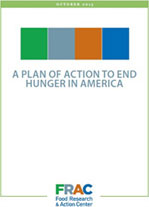Published March 31, 2025
Summer EBT, in conjunction with the traditional summer meals programs, provides key nutrition support to children when school is out by providing families with approximately $120 on an Electronic Benefit Transfer (EBT) card per summer per eligible child to help with food costs during the summer months. Summer EBT is a method proven to decrease food insecurity and improve nutrition. This summer, 38 states and the District of Columbia, five territories, and five Tribal organizations have opted to participate in the program.
As part of the budget reconciliation process, Congress is currently considering significant cuts to the Supplemental Nutrition Assistance Program (SNAP) and school meals. While Summer EBT is not explicitly included in the proposed cuts, any changes that limit participation in SNAP or school meals would have a negative ripple effect on Summer EBT by making it more challenging for states to administer the program, which would result in fewer children receiving this important nutrition benefit.
Eliminating Categorical Eligibility
One proposal that could have serious implications for Summer EBT is the proposal to end Broad-Based Categorical Eligibility (BBCE). Through BBCE, any school-age student in a household participating in SNAP, Temporary Assistance for Needy Families (TANF), or the Food Distribution Program on Indian Reservations, as well as children who are homeless, migrant, or in foster care are “categorically eligible” (automatically eligible) for free school meals and can receive Summer EBT benefits without submitting an application.
Cutting BBCE would negatively affect Summer EBT by:
- Complicating the application process: Families that participate in means-tested programs are automatically eligible for Summer EBT under current regulations, allowing them to bypass the need to navigate complex application processes. Losing this direct link to Summer EBT eligibility would result in more children falling through the cracks.
- Increasing the administrative burden: Without BBCE, schools and administering agencies would be required to process more Summer EBT applications. At a time when states are facing challenges with tight budgets, limited workforces, and timeliness, any increase in workforce requirements to reverse a well-established program would be disastrous.
Income Verification
Another proposal with repercussions for Summer EBT is one that would require all families applying for school meals to provide detailed household income documentation before being approved for free or reduced-price meals during the school year. This change would reduce access for eligible children and increase the administrative burden for schools. Requiring full income documentation has been shown to cause eligible children to fall through the cracks, resulting in many missing out on the nutritious meals they need.
Under current law, any student who received free or reduced-price school meals in the preceding school year is automatically certified for Summer EBT. Any decrease in the number of children certified for free or reduced-price meals would result in more families having to apply for Summer EBT, increasing the likelihood that they will lose access to the program.
Changes to the Thrifty Food Plan
The Thrifty Food Plan (TFP) was developed by the U.S. Department of Agriculture (USDA) to determine the weekly cost of buying food to maintain a healthy diet and sets the maximum SNAP monthly benefit. In 2021, a 21 percent increase was made to the TFP, the first adjustment outside of inflation adjustments in 50 years.
There are budget proposals under consideration that would either roll back TFP levels to pre-2021 levels or freeze current levels for the next 10 years. The Summer EBT statute set 2024 levels at $40 per child per month, with adjustments made in following years based on adjustments to the TFP. While any roll backs to the TFP would not drop the benefit level below $40, the proposed changes would lead to benefit adequacy issues within Summer EBT, at a time when the cost of groceries is expected to increase at a greater rate than average.
Cuts to CEP
Children who attend community eligibility schools must have an individual eligibility determination, which means that any proposed cut to the Community Eligibility Provision (CEP) would not have a direct immediate impact on Summer EBT. Students attending CEP schools must either be categorially eligible (as detailed above) to receive Summer EBT automatically or certified for free or reduced-price school meals through an application.
No Cuts to SNAP or School Meals
Summer EBT is a vital program that ensures that children have access to the nutrition they need during the summer months. Any efforts to weaken School Nutrition Programs or SNAP will have ripple effects on the Summer EBT Program, causing higher administrative burden on states, complicating the application process for families, and reducing the number of children eligible to participate. By protecting school meals and SNAP, we can ensure eligible children continue to have access to Summer EBT.


